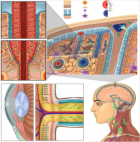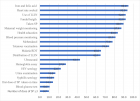Abstract
Short Communication
How Condylar modifications occurs
Rohit Kulshrestha*
Published: 31 December, 2018 | Volume 2 - Issue 1 | Pages: 018-019
Functional appliances used in correction of class II malocclusions are shown to modify the neuromuscular environment of dentition & associated bones. There are many studies related to the skeletal, dental and neuromuscular changes which are evaluated cephalometrically, clinically as well as with the recent diagnostic aids like MRI. The aim of this short communication was to highlight and discuss the different aspects of condylar modifications and its role in its growth.
The Twin Block has higher effectiveness & comfort as compared to other removable functional appliances [1.2]. The action of Twin Block & Bionator is for 24 hours so effects are more with these appliances. Over the years, several theories have emerged attempting to shed light on condylar growth. One of the earliest theories, the genetic theory, suggests the condyle is under strong genetic control like an epiphysis that causes the entire mandible to grow downward and forward. Although this may be related more to development of the prenatal than postnatal condyle, the theory does indirectly question the effectiveness of orthopedic appliances in condylar growth as proposed by Brodie [3,4]. Several long-term investigations actually showed clinically insignificant condylar growth modification after continuous mandibular advancement with a reasonable retention period in human beings although the initial treatment results appeared encouraging. This leads to the conclusion that the general growth of the condyle appears relatively unalterable in long-term studies.
A second hypothesis based on the earliest available acute and blind EMG monitoring technique, suggests that hyperactivity of the lateral pterygoid muscles (LPM) promotes condylar growth. Rees reported that other muscles and tendons, including those of the deep masseter and temporalis, also attach to the articular disk region. Attachments of the LPM to the condylar head or articular disk may be expected to cause condylar growth, but anatomic research has not found evidence that significant attachments actually exist [5,6]. The LPM tendon is observed attaching, however, to the anterior border of the fibrous capsule that in turn attaches to the fibrocartilage of the condylar head and neck anteriorly. At the same time, it is doubtful that initial hyperactivity could occur where the LPM muscle has been shortened by continuous mandibular displacement therapy. By using LPM myectomy in rats, which may have disrupted condylar blood supply, Whetten and Johnston found little evidence that LPM traction had any pronounced effect on condylar growth. More recently, permanently implanted longitudinal muscle monitoring techniques have found that the condylar growth is actually related to decrease postural and functional LPM activity. This notion was also supported in human studies by Auf der Maur, Pancherz and Anehus- Pancherz, and Ingervall and Bitsanis that reported decreased muscle activity. The LPM hyperactivity theory brought forward by Charlier et al. Petrovic, and later espoused by McNamara however, was important in prompting further investigations in muscle-bone interactions [7,8].
A third hypothesis, the functional matrix theory, postulates the principal control of bone growth is not the bone itself, but rather the growth of soft tissues directly associated with it. Although this was supported in part by investigations testing the different growth and developmental responses between the condyle and epiphysis, there has been no explanation as to exactly how condylar growth would be stimulated. Thus, this theory’s validity has been questioned. One of the reasons was that there was little explanation of the specific mechanism by which the condyle was stimulated to grow. Endow and Hans presented an excellent overall perspective suggesting that mandibular growth is a composite of regional forces and functional agents of growth control that interact in response to specific extra-condylar activating signals [9,10].
Read Full Article HTML DOI: 10.29328/journal.jcad.1001008 Cite this Article Read Full Article PDF
References
- Pancherz H. The Herbst appliance—its biologic effects and clinical use. Am J Orthod. 1985; 87: 1–20. Ref.: https://goo.gl/boQL1t
- Rabie AB, She TT, Ha¨gg U. Functional appliance therapy accelerates and enhances condylar growth. Am J Orthod Dentofacial Orthop. 2003; 123: 40–88. Ref.: https://goo.gl/A7gp9w
- Rabie AB, Xiong H, Ha¨gg U. Forward mandibular positioning enhances condylar adaptation in adult rats. Eur J Orthod. 2004; 26: 353–358. Ref.: https://goo.gl/cAaTX8
- Shen G, Rabie AB, Zhao ZH, Kaluarachchi K. Forward deviation of the mandibular condyle enhances endochondral ossification of condylar cartilage indicated by increased expression of type X collagen. Arch Oral Biol. 2006;51: 315–324. Ref.: https://goo.gl/eJnphG
- Fuentes MA, Opperman LA, Buschang P, Bellinger LL, Carlson DS, et al. Lateral functional shift of the mandible: Part II. Effects on gene expression in condylar cartilage. Am J Orthod Dentofacial Orthop. 2003; 123: 160–166. Ref.: https://goo.gl/WPjfq2
- Woodside DG, Metaxas A, Altuna G. The influence of functional appliance therapy on glenoid fossa remodeling. Am J Orthod Dentofacial Orthop. 1987; 92: 181–198. Ref.: https://goo.gl/mXkCJ8
- Hinton RJ, McNamara JA Jr. Temporal bone adaptations in response to protrusive function in juvenile and young adult rhesus monkeys (Macaca mulatta). Eur J Orthod. 1984; 6: 155–174. Ref.: https://goo.gl/9J3LiF
- Rabie AB, Zhao Z, Shen G, Ha¨gg EU, Dr O, et al. Osteogenesis in the glenoid fossa in response to mandibular advancement. Am J Orthod Dentofacial Orthop. 2001;1 19: 390–400. Ref.: https://goo.gl/898yhG
- Bergman RA, Afifi AK, Heidger PM. Histology. Philadelphia, Pa: WB Saunders; 1996.
- Shen G, Darendeliler MA. The adaptive remodeling of condylar cartilage—a transition from chondrogenesis to osteogenesis. J Dent Res. 2005; 84: 691–699. Ref.: https://goo.gl/UUmNdR
Similar Articles
-
Bilateral Parasymphyseal OsteomaAkanksha Gupta,Sangeeta Singh Malik,Swati Gupta,Ravi Prakash SM*. Bilateral Parasymphyseal Osteoma. . 2017 doi: 10.29328/journal.hjd.1001001; 1: 001-004
-
“Bulls Eye For Bulls Teeth”- Endodontic Management of Taurodontism Using CBCT as A Diagnostic Tool- 2 Rare Case ReportsSapna Sonkurla,Manoj Mahadeo Ramugade*,Shubha Hegde,Gopal Tawani. “Bulls Eye For Bulls Teeth”- Endodontic Management of Taurodontism Using CBCT as A Diagnostic Tool- 2 Rare Case Reports. . 2017 doi: 10.29328/journal.hjd.1001002; 1: 005-011
-
Diagnosis and Treatment of Anterior Cracked Tooth: A Case ReportWellington Luiz de Oliveira Da Rosa,Lucas Pradebon Brondani,Tiago Machado Da Silva,Evandro Piva, Fernandes Da Silva*. Diagnosis and Treatment of Anterior Cracked Tooth: A Case Report. . 2017 doi: 10.29328/journal.hjd.1001003 ; 1: 012-020
-
The Neuromuscular diseases in Pediatric Dental OfficeAmbarkova Vesna*. The Neuromuscular diseases in Pediatric Dental Office. . 2017 doi: 10.29328/journal.hjd.1001004; 1: 021-025
-
Fabrication of Lingual Retainer made easyMadhvi Bhardwaj, Shantanu Khattri,Rohit Kulshrestha*. Fabrication of Lingual Retainer made easy. . 2017 doi: 10.29328/journal.hjd.1001005; 1: 026-027
-
Staining susceptibility of recently developed resin composite materialsOlivier Duc,Emilie Betrisey, Enrico Di Bella, Ivo Krejci,Stefano Ardu*. Staining susceptibility of recently developed resin composite materials. . 2018 doi: 10.29328/journal.jcad.1001006; 2: 001-007
-
Preventing Peri-implantitis with a proper Cementation Protocol and with the consideration of alternatives to Cement-Retained Implant RestorationsTony Daher*,Robert G Mokbel, Vahik P Meserkhani. Preventing Peri-implantitis with a proper Cementation Protocol and with the consideration of alternatives to Cement-Retained Implant Restorations. . 2018 doi: 10.29328/journal.jcad.1001007; 2: 008-017
-
How Condylar modifications occursRohit Kulshrestha*. How Condylar modifications occurs. . 2018 doi: 10.29328/journal.jcad.1001008; 2: 018-019
-
Colour keys to emotion in management of children and intellectual distraction using coloured games in dental environment for childrenRajakumar S*,Kavitha Ramar, Revanth MP. Colour keys to emotion in management of children and intellectual distraction using coloured games in dental environment for children. . 2019 doi: 10.29328/journal.jcad.1001009; 3: 001-003
-
Cranio-Facial Fibrous Dysplasia: A case report of a conservative treatment in a monostotic form associated with an orthodontic management and a bone graft of the non-lytic bone area for dental implant rehabilitationSeban A*,Blein E,Perez S,Seban B. Cranio-Facial Fibrous Dysplasia: A case report of a conservative treatment in a monostotic form associated with an orthodontic management and a bone graft of the non-lytic bone area for dental implant rehabilitation. . 2019 doi: 10.29328/journal.jcad.1001011; 3: 018-022
Recently Viewed
-
Advancing Forensic Approaches to Human Trafficking: The Role of Dental IdentificationAiswarya GR*. Advancing Forensic Approaches to Human Trafficking: The Role of Dental Identification. J Forensic Sci Res. 2025: doi: 10.29328/journal.jfsr.1001076; 9: 025-028
-
Scientific Analysis of Eucharistic Miracles: Importance of a Standardization in EvaluationKelly Kearse*,Frank Ligaj. Scientific Analysis of Eucharistic Miracles: Importance of a Standardization in Evaluation. J Forensic Sci Res. 2024: doi: 10.29328/journal.jfsr.1001068; 8: 078-088
-
Sinonasal Myxoma Extending into the Orbit in a 4-Year Old: A Case PresentationJulian A Purrinos*, Ramzi Younis. Sinonasal Myxoma Extending into the Orbit in a 4-Year Old: A Case Presentation. Arch Case Rep. 2024: doi: 10.29328/journal.acr.1001099; 8: 075-077
-
Toxicity and Phytochemical Analysis of Five Medicinal PlantsJohnson-Ajinwo Okiemute Rosa*, Nyodee, Dummene Godwin. Toxicity and Phytochemical Analysis of Five Medicinal Plants. Arch Pharm Pharma Sci. 2024: doi: 10.29328/journal.apps.1001054; 8: 029-040
-
Antibacterial Screening of Lippia origanoides Essential Oil on Gram-negative BacteriaRodrigo Marcelino Zacarias de Andrade, Bernardina de Paixão Santos, Roberson Matteus Fernandes Silva, Mateus Gonçalves Silva*, Igor de Sousa Oliveira, Sávio Benvindo Ferreira, Rafaelle Cavalcante Lira. Antibacterial Screening of Lippia origanoides Essential Oil on Gram-negative Bacteria. Arch Pharm Pharma Sci. 2024: doi: 10.29328/journal.apps.1001053; 8: 024-028.
Most Viewed
-
Evaluation of Biostimulants Based on Recovered Protein Hydrolysates from Animal By-products as Plant Growth EnhancersH Pérez-Aguilar*, M Lacruz-Asaro, F Arán-Ais. Evaluation of Biostimulants Based on Recovered Protein Hydrolysates from Animal By-products as Plant Growth Enhancers. J Plant Sci Phytopathol. 2023 doi: 10.29328/journal.jpsp.1001104; 7: 042-047
-
Sinonasal Myxoma Extending into the Orbit in a 4-Year Old: A Case PresentationJulian A Purrinos*, Ramzi Younis. Sinonasal Myxoma Extending into the Orbit in a 4-Year Old: A Case Presentation. Arch Case Rep. 2024 doi: 10.29328/journal.acr.1001099; 8: 075-077
-
Feasibility study of magnetic sensing for detecting single-neuron action potentialsDenis Tonini,Kai Wu,Renata Saha,Jian-Ping Wang*. Feasibility study of magnetic sensing for detecting single-neuron action potentials. Ann Biomed Sci Eng. 2022 doi: 10.29328/journal.abse.1001018; 6: 019-029
-
Pediatric Dysgerminoma: Unveiling a Rare Ovarian TumorFaten Limaiem*, Khalil Saffar, Ahmed Halouani. Pediatric Dysgerminoma: Unveiling a Rare Ovarian Tumor. Arch Case Rep. 2024 doi: 10.29328/journal.acr.1001087; 8: 010-013
-
Physical activity can change the physiological and psychological circumstances during COVID-19 pandemic: A narrative reviewKhashayar Maroufi*. Physical activity can change the physiological and psychological circumstances during COVID-19 pandemic: A narrative review. J Sports Med Ther. 2021 doi: 10.29328/journal.jsmt.1001051; 6: 001-007

HSPI: We're glad you're here. Please click "create a new Query" if you are a new visitor to our website and need further information from us.
If you are already a member of our network and need to keep track of any developments regarding a question you have already submitted, click "take me to my Query."
















































































































































